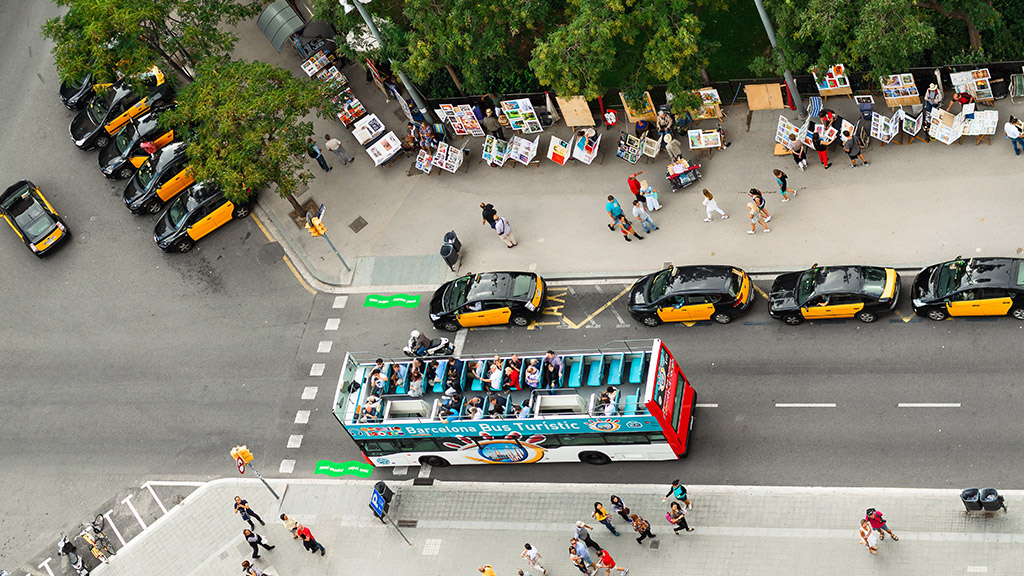The influx of tourists leaves some cities unrecognisable in summer. Residents are forced to live alongside thousands of visitors, who occasionally create conflicts. Tourism brings with it new challenges to be faced every day, but never more so than in summer. As temperatures rise, problems multiply and become more complex with the summer holiday season, when we see a "more intense use of certain areas of a city that, for various reasons, become even more attractive", to quote UOC University Master's Degree in Cities and Urbanism course instructor Miguel Y. Mayorga. "The resident population multiplies and this overcrowding, despite offering economic benefits, also has its negative impacts and can be a burden on the area in question", Mayorga stated.
Mirela Fiori, director of the Cities and Urbanism master's degree programme, called upon the case of Barcelona as an example. The city welcomes eight million tourists a year – the highest concentration in the warmest months – and the unrelenting presence of tourists has an impact not just on use of public spaces, but also on the environment, trade, public services and the housing market. In the last 15 years, the number of tourists visiting the city has practically doubled. "Even though the average visitor stays less than three nights, the city has this floating population, which every month represents 40% of the resident population", Fiori pointed out.
"Who are we making the city for?"
Despite tourism's evident benefits for the economy, public policy cannot ignore the series of problems it can create. Fiori believes that "city programmes and projects must take this pressure from tourism into account, as it puts residents' quality of life at risk". This is where the importance and ethics of urban planning come into play, the director of the Cities and Urbanism programme admitted: "Who are we making the city for? We cannot allow everything to be turned on its head just so tourism can benefit the major global operators". For his part, Mayorga warned that "the impacts at social, economic and environmental level have to be monitored and reviewed". To this effect, and particularly in the case of Barcelona, the course instructor believes that the focus should be on "a sustainable tourism model that brings the needs and rights of visitors in line with residents' everyday life".
For Fiori, one of the main issues is that "in every neighbourhood we have to ensure that all citizens have access to housing and the public space, that small neighbourhood commerce is protected and that there are a range of facilities available". For this reason, she warned that "rather than very original ideas, we need there to be a political will at all the different levels". Even though it is evident that, on the face of it, the public space is without a doubt where the pressure of tourism is most felt, it is multidimensional", so "we cannot act in the public space without taking all of the rest into account", stressed the programme director. She recommends that the issue be tackled "at its heart and across the board".
When the residents carry the can
Faculty of Psychology and Education Sciences professor Pep Vivas points to how tourist behaviour can put the city at risk. Not all visitors give the city the respect it deserves. As he explained, some visitors act very differently to how they would in their home towns because "they do not have time to get to know and feel a connection with the city they are visiting". This leads to unsustainable behaviour. The cost of all this ends up falling to the residents, who also have to live with another effect: everything begins to cost more. According to Vivas, the impact on residents' standard of living is clear: "The city's habitual residents find they have less and less money; tourist cities may reach the desired economic indicators, but they have increasingly more social problems".
Overuse of the public space and infrastructures also causes residents to harbour ill will. The residents feel that the city is becoming gentrified in many ways. "Tourist gentrification", Vivas pointed out, "exacerbates the problem and the ill feeling among the public today, leading citizens to protest or express the dissatisfaction felt among those who have lived their entire lives in a specific city". He said that one solution would be to "stop the feeling of being invaded by tourists, which leaves some groups and residents in Barcelona demanding their rights, and very rightly so". He gave the example of placing a limit on numbers of cruise liners.
This need for regulation is also championed by Professor Mayorga, who insists that regulations "have to work on social pacts that enable us to bring about a change of trend when searching for social, economic and environmental balance". The challenge is for cities that make themselves attractive to tourism to not become a social hell for those who live there. This, stated Mayorga, demands "a great deal of political work, technical skill and social awareness".
Experts UOC
Press contact
-
Editorial department

